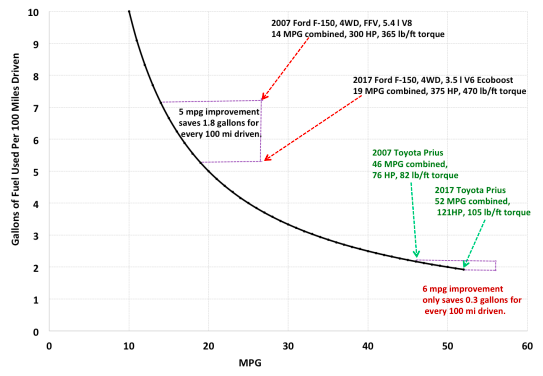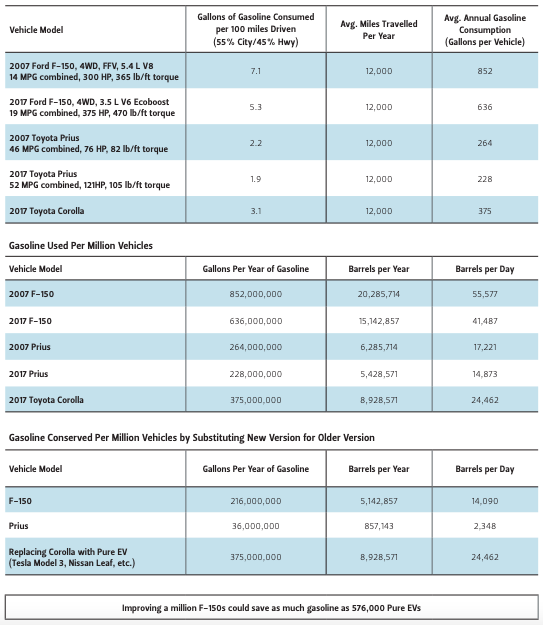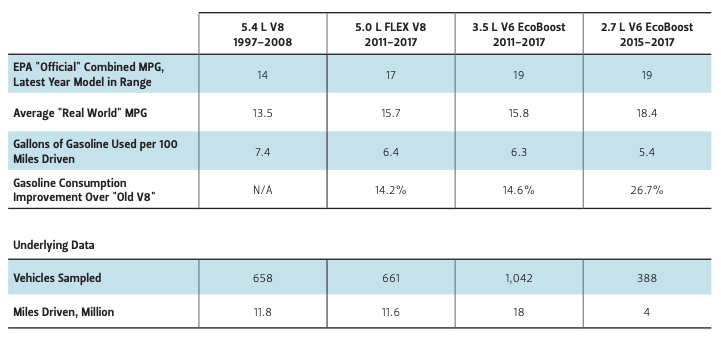Seeking Scalable, Cost-effective Reductions in Gasoline Demand and Tailpipe Emissions? Focus on Pickup Trucks, Not Priuses

Table of Contents
Author(s)
Share this Publication
- Download PDF
- Print This Publication
- Cite This Publication Copy Citation
Collins, Gabriel. 2017. Seeking Scalable, Cost-effective Reductions in Gasoline Demand and Tailpipe Emissions? Focus on Pickup Trucks, Not Priuses. Policy brief no. 06.14.17. Rice University’s Baker Institute for Public Policy, Houston, Texas.
U.S. sales of large passenger vehicles have boomed for most of the past decade. Yet despite continued reliance on gasoline propulsion in the U.S. and a trend toward larger, more powerful vehicles, the 7.6% rise in miles driven seen from February 2012 to February 2017 yielded a gasoline demand increase of only 3.8%.1 Better engine technology likely underpins much of the rising gasoline consumption efficiency on U.S. roads and the big, powerful pickups and SUVs cherished by many American drivers are at the center of the action.
Per 100 miles driven, improving the fuel economy of a single Ford F-150 by five miles per gallon (MPG) can theoretically achieve the same volumetric gasoline savings that would be accomplished by making a six MPG improvement to six Priuses (Figure 1).2 As Duke University’s Fuqua School of Business Professors Richard Larrick and Jack Soll put it in their groundbreaking 2008 piece “The MPG Illusion,” “Relying on linear reasoning about MPG leads people to undervalue small improvements on inefficient vehicles.”3 This insight should shape transportationfocused energy and environment policies moving forward.4
Figure 1 — Thirstier Vehicles Offer the Highest Return on Fuel Efficiency Investment5

Larger trucks and SUVs with powerful, high-displacement engines are the low-hanging fruit for any policymaker seeking the most efficient path to reducing gasoline use and the associated emissions. This suggests capital investments focused on the larger vehicles Americans favor can most rapidly save the largest quantities of fuel and avoid more emissions at less cost. Focusing on SUVs and trucks also acknowledges the reality that when truck owners get new vehicles, they typically move into another truck or SUV, often of the same brand and type—not a compact car. As such, turnover in the existing pickup and SUV vehicle stock is likely to be a more powerful driver of fuel economy gains, especially in the next five years, than adoption of smaller or totally new vehicles such as EVs.
Consider the following: As Tesla prepares to bring the Model 3 to market, a recent survey of 800 Model 3 reservation holders reveals that they “are more than twice as likely to own a Toyota as any other brand, whereas current Tesla owners are four times as likely to own a BMW as any other brand.”6 In other words, many prospective Tesla owners plan to jump from vehicles that are already fairly fuel efficient into pure battery-powered rides. As such, the gasoline demand displacement from their move to the Model 3 will, in aggregate terms, be much smaller than what is likely to be achieved through adoption of more fuel-efficient engines in larger trucks and SUVs.
This author estimates that, assuming driver behavior and miles driven remain constant, each million “modern” Ford F-150s that replace older trucks could potentially displace as much as 14,000 barrels per day of gasoline demand (Figure 2). Using a vehicle miles travelled (VMT) number of 15,000 miles driven per year, as Ford does in its own fuel economy analyses, raises the potential displacement to nearly 18,000 barrels per day of gasoline per million new-edition F-150s that enter the fleet.7
Figure 2 — Gasoline Displacement Analysis

To put these displacement numbers into perspective, the likely gasoline demand reduction from replacing 1 million 2007 F-150s (i.e., the old V-8 engine models) with the truck’s 2017 3.5 liter EcoBoost edition is the same as 576,000 drivers turning in their 2017 Toyota Corollas (or other similar small, highly fuel-efficient cars) for Tesla Model 3s, which use no gasoline at all. Tesla has only delivered 208,000 vehicles since the first quarter of 2013—a span of 48 months and counting.8 Total plug-in electric vehicle sales since January 2012 in the U.S. market number slightly over 600,000 units.9 In contrast, Ford can produce and sell 1 million F-150s in less than 18 months. Other manufacturers of large, gasoline-intensive vehicles can produce at a similar scale.
EPA Ratings vs. “Real World Fuel Economy” and How More Efficient Pickup SUV Engines Are Affecting Gasoline Demand Growth
Since the Ford F-150 pickup with the EcoBoost engine option debuted in 2011, an intense debate has emerged over whether smaller-displacement turbocharged engines are really as fuel efficient as manufacturers (using U.S. EPA ratings) claim them to be. Several prominent auto industry publications have published detailed analyses suggesting that “real world” mileage of the new turbocharged motors in fact significantly lags the official EPA fuel economy ratings.10 Other testers, such as the judges behind the 2016 Canadian Truck King Challenge, have found combined mileage ratings that more closely approximate the EPA combined rating of 19 MPG.11
The EPA assessment cycle may be unrealistically “gentle” and not fully reflect how trucks are actually driven. Under “real world” conditions, manufacturers often adjust fuel mixtures to manage temperatures in turbocharged engines by using a richer fuel-air blend to help limit maximum temperatures.12 Therefore, when drivers accelerate hard and pull trailers, vehicles produce ample power—but at the expense of fuel efficiency due to the use of extra fuel to control engine operating temperature. Yet even if the fuel economy of turbocharged motors—especially in trucks and SUVs—may be falling short of window sticker levels, engine technology improvements still appear to be materially depressing gasoline consumption.
Fuelly, a web portal that crowd sources fuel economy data as member drivers enter fuel usage and miles driven data, offers one possible way of assessing real world fuel usage. To maintain consistency with the featured large vehicle in Figure 1 (the F-150 pickup), this study utilizes Fuelly data for the following variants of the F-150: (A) 3.5 liter V6 EcoBoost motor (2011-2017 model years, 1,042 vehicle sample size, 18 million miles driven); (B) 2.7 liter V6 EcoBoost motor (2015-2017 model years, 388 vehicle sample size, 4 million miles driven); and (C) 5.4 liter V8 motor (1997-2007 model years, 658 vehicle sample size, 11.8 million miles driven). The data include trucks of all body types and styles for each engine, meaning that more efficient two-wheel-drive vehicles powered by a given motor are included alongside less efficient four-wheel-drive models.
Fuelly’s data suggest that the EcoBoost F-150s’ actual fuel economy results often do fall short of the EPA figures, but still represent a significant improvement over the largedisplacement legacy 5.4 V8-engine trucks that they are likely replacing as owners upgrade to newer vehicles (Figure 3). It also bears noting that the second-generation EcoBoost 3.5 liter engine used in the 2017 F-150 shows higher fuel economy, with Wards Auto editors recording average fuel economies of between 16.5 MPG and 19 MPG during “real world” tests with the truck.13
Figure 3 — Even When Turbocharged Motors Fall Short on Real World Mileage, They Still Offer a Meaningful Improvement Over Older Truck's Gasoline Intensity

Among the most interesting insights from the Fuelly data is that Ford’s Coyote 5.0 liter V8 engines basically appear to deliver practical mileage on par with the 3.5 liter EcoBoost. Accordingly, the story of incremental improvements driving greater fuel efficiency is not just restricted to the boosted engines, but also extends to the large-displacement, naturally aspirated motors as well. The Ford 5.0 liter V8’s significant improvements in fuel economy and power delivery over its 5.4 liter predecessor are mirrored by the Chevy Silverado, whose 2017 edition achieves 20 MPG on the highway with a large 6.2 liter V8 motor producing a stout 420 HP and 460 lb/ft of torque.14
Potential Gasoline Demand Impacts
Mass market turbocharged engines for pickups and SUVs are still in the early innings of both market penetration and technology development. As such, if miles driven remain steady or decrease and improved engine technologies cycle into an ever-larger portion of the vehicle fleet, U.S. gasoline demand could soon begin to structurally decline.
Penetration rates for the most advanced, fuel-efficient trucks and SUVs (relative to others in their class) remain relatively low. Consider the following market penetration data from 2015:
- four-cylinder vehicles (60.8% overall turbo penetration, 11.9% for trucks)
- six-cylinder vehicles (4.5% overall turbo penetration, 17.9% for trucks)
- eight-cylinder vehicles (2.5% overall turbo penetration, 0.5% for trucks)15
The vehicle groups with larger engines still hold a big upside for increased fuel efficiency, both without changing the number of cylinders, and by putting downsized, high-output turbo engines in larger vehicles. The movement from eight cylinders down to six—and six cylinders down to four—has gained momentum through sales of vehicles such as the F-150; a majority of the trucks sold now are six-cylinder EcoBoosts replacing eight-cylinder V8s, and the Ford Explorer and Mazda CX-9, which offer boosted four-cylinder powerplants in place of V6 motors.16
To contextualize the market scale in play here, the total U.S. fleet of light trucks and passenger cars currently stands at approximately 264 million, with 11 million vehicles being scrapped each year and roughly 17 million new ones being sold.17 Ford has to date likely sold at least 1.5 million EcoBoost-equipped F-150s.18 While the figure seems large in absolute terms, Ford has sold at least 11 million F-Series trucks since 2002, the bulk of which are F-150s.19 The EcoBoost powerplant has only been used in F-150s since 2011.
The pool of non-EcoBoost Ford trucks potentially eligible for substitution is thus likely on the order of 9 million units. Multiplying that figure by the gasoline displacement estimates above suggests an additional 120 kbd of gasoline demand could be removed just by upgrades within the F-150 pool. Other truck makers are also likely to incorporate more efficient engine technologies in coming years, increasing the possibility for gasoline demand erosion.20
Along with scale, engine technologies are also successively improving. As large and medium-sized vehicles are paired with new, downsized motors, a window opens for introducing new fuel-saving technologies. For instance, the 2016 Mazda CX-9 marks the first use of cooled exhaust gas recirculation ( or “cooled EGR”) in a turbocharged four-cylinder motor with direct fuel injection.21 Auto parts manufacturer Mahle Behr conducted tests with cooled EGR systems on a turbocharged three-cylinder 1.2 liter direct-injection gasoline engine and found that at the highest speeds and loads, cooled EGR delivered a 9% improvement in fuel economy.22
While the EcoBoost motors do not yet use cooled EGR, much space remains for bolstering fuel efficiency as successive generations of truck-oriented engines enter service. Indeed, at least one Ford technical presentation from 2013 explicitly says that cooled EGR is “under development” for potential inclusion in future EcoBoost engine generations.23
Policy Implications
The speed and scale of economic, energy, and environmental returns on investments to improve internal combustion engines are magnified by the fact that this path allows us to leverage existing fueling infrastructure that was built at great cost—and, which generally speaking, has worked very effectively for decades. From a policy perspective, the data shown here suggest that dollars invested in research to improve internal combustion engines and promote gasoline-based hybrid vehicles are likely to yield larger—and faster—returns than investments in battery electrics. The bigger question is whether policymakers will be willing to confront the political optics of appearing to “double down” on gasoline, when doing so in fact represents the rational first step down a longer road toward a lower-oil use, lower emissions propulsion future.
This issue exists not just in the U.S., but also in other major global auto markets—first and foremost, China. Chinese car buyers are thus far showing a strong preference for SUVs, and gasoline demand outlooks for the country are accordingly bullish.24 Yet the significant simultaneous improvements in engine power and fuel economy seen in the U.S. mesh well with the stated preferences of drivers in China. Only one-third of respondents to an online survey of actual and prospective Chinese car owners conducted by turbocharger manufacturer Honeywell Technologies in 2014 were satisfied with their current vehicle’s fuel economy and power.25 Eighty percent of respondents said they desired fuel economy savings of at least 10 to 30% in order to be satisfied with their next vehicle purchase.26 Beyond this, 94% of respondents indicated engine performance was an “important” or “very important” factor for purchasing a vehicle, and 68% of respondents said they would prefer to buy a smaller car if it could still perform like a vehicle with a larger engine.27 These preferences suggest a future in which greater use of advanced engine and powertrain technologies helps restrain Chinese gasoline demand growth below forecast levels.
So how can the U.S. federal government incentivize the development and sales of even more efficient internal combustion engine vehicles? One possible way would be to provide federally funded tax credits to manufacturers for each 0.1 gallon of fuel saved per 100 miles driven on each new “high-displacement” vehicle sold. “High-displacement” motors would have a displacement greater than 3.0 liters. Fuel savings would be determined by consumption per 100 miles driven compared to the analogous model from 10 years prior (or five years, for newer models). For instance, the highest horsepower F-150 from the 2007 lineup would be the basis of comparison for the most powerful F-150 offered for sale in 2017. Each manufacturer could claim credits from the first million new vehicles sold each year, from any of its high-displacement models.
As an initial proposition, the IRS could deem each 0.1 gallon potential reduction in fuel consumed per 100 miles driven to be worth $100 in tax credits per vehicle sold. Accordingly, moving a vehicle from a combined rating of 16 MPG/6.3 gal per 100 miles to 20 MPG/5.0 gal per 100 miles could allow the manufacturer to claim a $1,300 tax deduction for that vehicle. Making the same fuel economy jump on 1 million vehicles sold would allow an automaker to claim a $1.3 billion tax deduction. A tax credit based on fuel economy improvements may also become more attractive as a flood of used SUVs and trucks coming off leases hits the U.S. market over the next two to four years and potentially begins eroding profit margins on new vehicle sales.28
A second path to gasoline demand reductions would be to test turbocharged vehicles over a more realistic drive cycle that is more representative of “real world” demands placed on turbocharged engines. The tax credit system outlined above would help incentivize manufacturers to build engines that deliver higher fuel economy under practical conditions, using technologies such as cooled EGR that are currently less in vogue because they do not significantly improve fuel economy under the presently gentle EPA test cycles.
From an energy and environment perspective, improving 1 million pickups or SUVs that each drive 12,000 miles per year from a 16 MPG to a 20 MPG fuel economy level would remove more than 10 kbd of gasoline demand.29 U.S. total sales of new pickups and SUVs—a sizeable portion of which would qualify as “high-displacement” vehicles—exceeded 10 million units in 2016.30 Such volumes suggest policies that explicitly compensate automakers for improving fuel economy in larger vehicles could conservatively yield an annualized gasoline demand reduction of more than 50,000 barrels per day in its initial years as the modernized vehicles are cycled into the fleet.
Over a five-year period, the new policy could shave at least 250 kbd off U.S. gasoline demand—more than one year of Chinese gasoline demand growth. Such reductions would likely allow the ultracompetitive U.S. refining sector to become an even larger global gasoline exporter. To boot, reducing gasoline demand by 250 kbd would eliminate 34 million tonnes per year of CO2 emissions—the equivalent of ten 500 MW coal-fired power plants.31 Gasoline's days as the world's core motor fuel are far from over. In fact, the most likely future is one with two coexisting vectors where gasoline gets used more efficiently—in many cases as part of a hybrid-electric powertrain.
Endnotes
1. “2016 U.S. auto sales set a new record high, led by SUVs,” Los Angeles Times, January 4, 2017, http://lat.ms/2knDZOB. And see, for instance, “NADA Market Beat: April 2017,” National Automobile Dealers Association, http://bit.ly/2rGAjK9. Gasoline demand is measured via EIA data for “Product Supplied,” which is widely treated as a proxy for gasoline consumption.
2. There is currently a robust debate on the “true” fuel economy of the EcoBoost turbocharged gasoline engines Ford is using in its F-150 pickup truck line. Results to date offer a mixed picture. For instance, Car and Driver’s testers found that the 2017 F-150 with a 3.5 liter EcoBoost engine delivered a combined city/highway fuel economy of 15 MPG, lagging the 19 MPG reported by the EPA (http://bit.ly/2skqH8V). Conversely, Wards Auto editors recorded average fuel economies of between 16.5 MPG and 19 MPG during “real world” tests with the same truck model. See Bob Gritzinger, “Powertrain Gains for ’17 Ford F-150,” Wards Auto, January 30, 2017, http://bit.ly/2sIjLzP.
3. Richard P. Larrick and Jack B. Soll, “The MPG Illusion,” Science 20 (June 20, 2008), http://bit.ly/2sIyk6u.
4. Here we note that there are also innovative companies stepping into the Class 8 heavy truck space with technology improvements and redesigns that could meaningfully reduce diesel fuel demand from heavy trucks. See, for instance, the Nikola One, a Class 8 electric hybrid tractor being built by the Nikola Motor Company, https://nikolamotor.com. This analysis focuses on passenger vehicles and gasoline because in the U.S. highway-driven oil products market, nearly 3.5 barrels of gasoline are consumed for each barrel of diesel burned. In addition, the entire North American market for new Class 8 trucks is approximately 250,000 units per year, as opposed to more than 17 million new passenger vehicles sold in 2016. See, for instance, Jerry Hirsch, “After Tough 2016, Heavy-Duty Truck Orders Rise in January,” Trucks.com, February 3, 2017, http://bit.ly/2s1sYFc.
5. The Wall Street Journal recently published a similar curve (Jo Craven McGinty, “Gas Guzzlers’ Gains in Fuel Efficiency Go Farther Than Fuel Sippers’ Do,” The Wall Street Journal, April 21, 2017, http://on.wsj.com/2s986wQ). This analysis dives deeper into the concept, how it is unfolding, and what some of the potential gasoline demand impacts may be on the macro level.
6. Edward Niedermeyer, “Model 3 Reservation Holder Survey Underlines Tesla’s Mass Market Challenge,” Daily Kanban, March 8, 2017, http://bit.ly/2skcRDB.
7. Edward A. Sanchez, “Ford F-150 EcoBoost Reaches 1 Million Sales Milestone,” Truck Trend, June 29, 2016, http://bit.ly/2s9jf0P.
8. Sourced from Tesla quarterly financial reports, http://ir.tesla.com/results.cfm.
9. “Monthly Plug-In Sales Scorecard,” Inside EVs, May 2017, http://insideevs.com/monthly-plug-in-sales-scorecard/.
10. K.C. Colwell, “2017 Ford F-150 3.5L EcoBoost 10-Speed Automatic 4x4,” Car and Driver, http://www.caranddriver.com/reviews/2017-ford-f-150-35l-ecoboost-10-speed-automatic-test-review; Dan Edmunds, “2015 Ford F-150 Long-Term Road Test,” Edmunds, May 6, 2016, http://edmu.in/2rGAjK8; Tom Murphy, “Where’s the Eco in EcoBoost?,” Wards Auto, January 6, 2015, http://bit.ly/2rGmGKE.
11. The F-150 used in the 2016 Canadian Truck King Challenge—powered by a 3.5 liter turbocharged EcoBoost engine and over loop courses that were sequentially driven empty, with a 1,000 lb in-vehicle payload, and towing a 6,000 lb trailer—delivered a combined average fuel economy of approximately 5.44 gallons per 100 miles, or 18.4 MPG. (Stephen Elmer, “2016 Real World Fuel Economy Report,” http://bit.ly/2r77mbg). The U.S. EPA’s data for the 2017 F-150 4WD with the 3.5 liter EcoBoost powerplant show a combined city/highway fuel economy of 19 MPG. (“2017 Ford F150 3.5L 4WD GVWR>7599 LBS,” FuelEconomy. gov, http://bit.ly/2rRqMyi).
12. Sami Haj-Assaad, “Why Turbocharged Cars Don’t Live Up to the MPG Hype and What Mazda is Doing About It,” AutoGuide.com, June 10, 2016, http://bit.ly/2skt6Ax.
13. Bob Gritzinger, “Powertrain Gains for ’17 Ford F-150,” Wards Auto, January 30, 2017, http://bit.ly/2sIjLzP.
14. Joe Grove, “Chevrolet Silverado 1500—In-Depth Review,” Car and Driver, February 2017, http://bit.ly/2rb6MEH.
15. Aaron Isenstadt, John German (ICCT), Mihai Dorobantu (Eaton), David Boggs (Ricardo), Tom Watson (JCI), “Downsized, boosted gasoline engines,” International Council on Clean Transportation, Working Paper 2016-21, http://bit.ly/2sIM2q3.
16. Christian Seabaugh, “2016 Ford Explorer 2.3L Ecoboost AWD First Test Review,” Motor Trend, MotorTrend.com, http://bit.ly/2sZnjgu; “New steel-intensive Mazda CX-9 sheds mass, debuts new turbo system,” SAE International, May 24, 2016, http://articles.sae.org/14841.
17. “Vehicles Getting Older: Average Age of Light Cars and Trucks in U.S. Rises Again in 2016 to 11.6 Years, IHS Markit Says,” IHS Markit, November 22, 2016, http://bit.ly/2iqN9b0.
18. Edward A. Sanchez, “Ford F-150 EcoBoost Reaches 1 Million Sales Milestone,” Truck Trend, June 29, 2016, http://bit.ly/2s9jf0P.
19. Timothy Cain, “Ford F-Series Sales Figures,” January 1, 2011, http://bit.ly/2r13zIB.
20. Consider, for instance, Ram’s EcoDiesel powertrain. See http://bit.ly/2sk8PuZ.
21. “New steel-intensive,” SAE International, May 24, 2016, http://articles. sae.org/14841.
22. “Cooled EGR Shows Benefits for Gasoline Engines,” SAE, September 17, 2014, http://articles.sae.org/13530.
23. J. James Yi, “IC Engine Combustion Research, Development, and Challenges,” June 5, 2013, http://bit.ly/2r7tO47.
24. See, for instance, Trefor Moss and Brian Spegele, “Gas Guzzlers Rule in China,” The Wall Street Journal, May 21, 2017, http://on.wsj.com/2ru5PM2 (noting that “Surging SUV demand will help propel oil consumption in China upward for at least the next decade.”).
25. Gabriel Collins, “China’s Evolving Oil Demand: Slowing Overall Growth, Gasoline Replacing Diesel as Demand Driver, Refined Product Exports Rising Substantially,” Baker Institute Working Paper, September 30, 2016, http://bit.ly/2sZmXXa.
26. Ibid.
27. Ibid.
28. To see the rapid growth in leased SUVs and, to a lesser extent, trucks, see “Lease Market Report, Edmunds, January 2017, http://bit.ly/2r0yy7O.
29. (100 miles/16 MPG) – ( 100 miles/20 MPG) * (12,000 miles/100 miles) * 1 million vehicles = 228 million gallons of gasoline per year. Divided by 42 gallons per barrel and 365 days per year, this yields 14.8 kbd.
30. Carly Schaffner, “Trucks, SUVs Dominate Record 2016 Auto Sales,” Trucks. com, January 4, 2017, http://bit.ly/2rGlUxu.
31. 0.373 tonnes CO2/bbl gasoline * 250 thousand bpd * 365 days per year = 34.036 million tonnes of CO2, http://bit.ly/2skdbSA; Coal-fired power plant CO2 emissions data from “The Future of Coal,” Executive Summary, page ix, MIT, 2007, http://bit.ly/1O7qHub.
This material may be quoted or reproduced without prior permission, provided appropriate credit is given to the author and Rice University’s Baker Institute for Public Policy. The views expressed herein are those of the individual author(s), and do not necessarily represent the views of Rice University’s Baker Institute for Public Policy.



